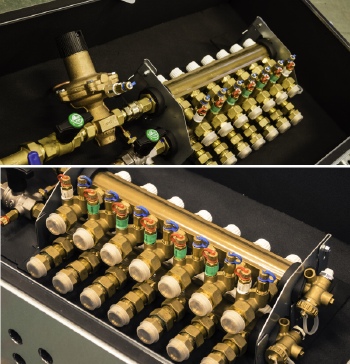What manifolds bring to commissioning

Grouping a number of terminal units together with a manifold offers major benefits for installation and commissioning. Nick Martin of Marflow Hydronics takes a look at their real advantages.
Manifolds were first introduced as a way of making sure sufficient differential-pressure-control valves (DPCVs) were used in hydronic distribution systems. Rather than just the minimum, instead a DPCV would be used for every four to six terminals.
Like many products, though, they have developed. DPCV versions are still available, but the more popular solutions nowadays are manifolds with pressure-independent control valves (PICVs). These are used instead of the standard 2-port control valves which, in turn, removes the need for separate DPCVs as one is already included with each PICV.
A PICV is a multi-functional valve that combines the operation of three different valves in one — a differential-pressure control valve, a regulating valve and a 2-port control valve. Using PICVs in a manifold unit not only reduces the number of separate valves but it also maintains better control of valve authorities.
One of the key benefits to using a manifold system is the time saving in installation. Manifolds are made up of centralised clusters of valves, so instead of having to flush the bypasses or balance the valves in lots of different places, the manifold combines everything in one location. In addition, when you install the product, fewer pipework connections need to be made. Between the manifold and the terminal, multi-layer pipework, which can be readily formed by hand, can be used to make point-to-point connections, ensuring a much easier job.
It is always a huge advantage if installation time can be reduced, but manifolds offer quite a lot more — such as helping greatly with commissioning.
The basic commissioning procedures are much the same when using manifolds as with standard systems, so suitable commissioning methods should be chosen for the valves fitted. In the case of manifolds with a DPCV, which is a manually set valve, the DPCV keeps the pressure constant and reduces interactivity between the valves. However, PICVs are pressure independent, so setting them is as simple as adjusting the hand wheel.
Although the method for commissioning will remain the same, the big difference with using manifolds comes once again down to the time spent. With other products, a lot of time is taken up by having to move from one location to another. If you have six PICVs, for example, then you’d have to move a podium six times. With manifolds, on the other hand, everything is located in the same place, so all the set up can be done in one location.
Other benefits include the fact that the manifolds can be pre-lagged and the pipework connections are far easier to work with. The multi-layer pipework can be cut to length and supplied pre-insulated, whatever is needed for that particular job.

There is another major benefit to using manifolds. If flows are low, then by grouping the terminals together it is possible to achieve a balance by using a suitably selected measuring device. The terminals can then be commissioned by exception. CIBSE’s ‘Commissioning code W: water distribution systems’ describes how to do this in more depth, but it is basically a way of measuring flows that are too small to measure any other way.
This exception approach is aimed more at heating manifolds, and uses a subtraction technique to identify problem valves. It is based on knowing the design flow rate for each valve and, in turn, the total flow rate for a group of terminal devices.
Isolating a correctly functioning valve will have a predictable effect on the total flow for the remaining valves. An unexpected result indicates a problem.
To identify problem circuits with conventional proportional balancing, the entire system must first be balanced, and then, when the problems have been resolved, the entire system has to be balanced again, which is quite a lengthy process that can affect the whole construction schedule. This alternative method makes life much easier, and troubleshooting becomes a far simpler task.
The capital costs for using a manifold system can be higher if the design is not optimally configured, but their popularity comes from the vast amount of time that can be saved by their use. Money on projects is always best saved on labour, and this is where the manifold can offer its highest returns.
Nick Martin is technical manager with Marflow Hydronics.







